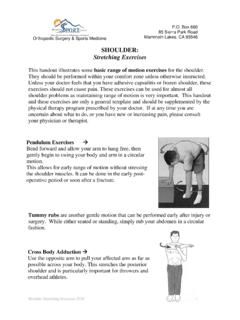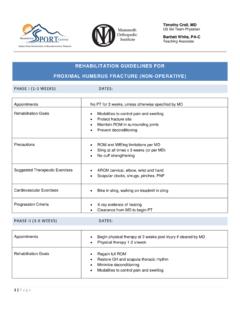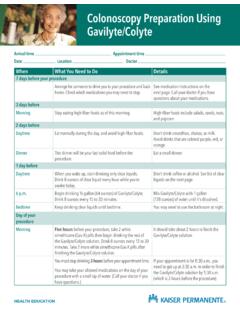Transcription of POST OPERATIVE INSTRUCTION: DISTAL RADIUS FRACTURE …
1 M a m m o t h O r t h o p e d i c I n s t i t u t e 8 5 S i e r r a P a r k R o a d M a m m o t h L a k e s , C A 9 3 5 4 6 7 6 0 . 9 2 4 . 4 0 8 4 POST OPERATIVE INSTRUCTION: DISTAL RADIUS FRACTURE ORIF ACTIVITY You may NOT bear weight with your affected arm until cleared by your physician. You should move (straighten and bend) your fingers at least 10 times per day within your comfort to decrease swelling and prevent stiffness. You may move your shoulder (raise it overhead) and elbow (bend and straighten) within your comfort to decrease swelling and prevent stiffness. You may be able to do some typing or writing right after surgery.
2 But, swelling or stiffness may make it hard to do these things for 3 to 4 weeks after surgery. DRESSINGS & INCISIONS The first two days after surgery you can expect a small amount of red-tinged drainage on your dressings, this is normal. Please keep the dressing clean and dry; if you are going to shower/bathe, you must protect the dressing. You may not soak in a pool, lake, hot tub, or the ocean until the sutures have been removed and your incisions are completely closed. Do not remove any of the dressings. Do not use Bacitracin or other ointments on the incisions. PAIN & INFLAMMATION Ice - Apply ice bags wrapped in a dry towel several times per day for 20 minutes for the first week and then as needed for pain relief and inflammation.
3 Elevation - Keep your arm elevated above your heart as much as possible for the first 3 to 4 days. Pain Medication You have been given a prescription for pain control; please take as directed. o If you think you will require a refill on your medication, you MUST do so during our regular weekday office hours. Please allow 48 hours for your prescription to be refilled. o If you need additional pain medication you may take Tylenol 500-650mg every 4-6 hours. Do not take more than 3grams or 3000mg in a 24 hour period! o Common side effects of the pain medication are: NAUSEA: To decrease nausea, take these medications with food .
4 DROWSINESS: Do not drive a car or operate machinery. ITCHING: You may take Benadryl to alleviate any itching. CONSTIPATION: To decrease constipation, use the stool softener provided (Docusate 250mg) or over-the-counter remedies (Mineral Oil, Milk of Magnesia, etc). Also avoid bananas, rice, apples, toast, and these foods can make you constipated. Getting up and moving around also helps with constipation and waking up your intestinal tract. anti - inflammatory medications (Aleve, Ibuprofen, Naproxen, etc.) should not be taken for 2 weeks after surgery. EMERGENCIES Please have someone stay with you for the first 24 hours after surgery Please call the clinic or the orthopaedist on-call if: o Drainage from the incision soaks the dressings, expands, is foul-smelling; or your incisions are red, warm, and extremely painful.
5 O You develop a fever (> ) or chills o You experience leg or calf pain, leg swelling, or difficulty breathing. FOLLOW-UP CARE Please schedule a follow-up visit for suture removal, and to review your surgery 10-14 days postoperatively. IF YOU HAVE ANY QUESTIONS OR CONCERNS, PLEASE FEEL FREE TO CALL THE OFFICE (760-924-4084). M a m m o t h O r t h o p e d i c I n s t i t u t e 8 5 S i e r r a P a r k R o a d M a m m o t h L a k e s , C A 9 3 5 4 6 7 6 0 . 9 2 4 . 4 0 8 4 FREQUENCY Physical therapy is initially 1-2 times weekly depending on the ability of the patient to follow-through at home.
6 Therapy may be increased to 3 times weekly for patients who are not progressing well. DAY 3-7 Initial evaluation to include evaluation of o AROM of shoulder, elbow, forearm, wrist, digits o Edema o Patient s usual daily activities o Functional limitations o Sensation o Instruction in AROM home program shoulder, elbow, forearm, wrist and digits Patient to continue ice packs or polar pack for edema Initiate massage for edema Fabricate resting wrist splint which allows movement of fingers WEEK 2-3 Continue splint use Continue AROM Add gentle PROM and joint mobilizations if okayed with MD May use heat if joint stiffness is present.
7 Continue use of cold pack after exercise. Emphasize combining digit flexion with wrist extension in activities such as grasping beans or rice Continue edema management with massage. Add compressive wrap if edema is significant WEEK 4-5 Continue splint use Add gentle PROM if FRACTURE is beginning to heal and full ROM has not yet been achieved Increase functional activities that are minimally or non-resistive Initiate gentle strengthening WEEK 6-8 Wean from splint Joint mobilization and PROM as needed to gain full ROM Progress strengthening for entire upper extremity Work simulation tasks If the patient has met goals by week 8, they may be discharged with a home program to continue to gain end range and strength.
8 Keep in mind that full function after a wrist FRACTURE usually takes at least 6 months and up to 2 years to achieve. Emphasize to the patient the need to continue home exercises as well as the fact that they will continue to improve for quite some time. Those patients who have not met goals due to complications or having a complex FRACTURE may need to continue therapy longer than 8 weeks post-op.









